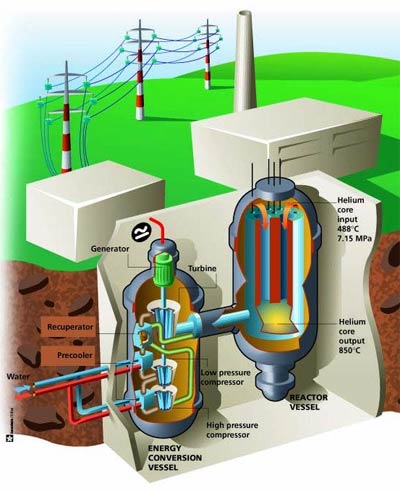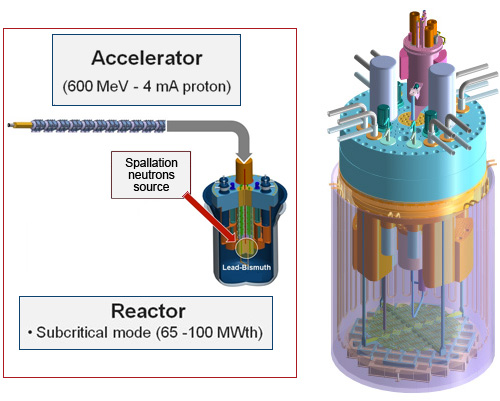A far away objective for Generation IV and 2040…
At the time of the first tests on the transmutation of americium and neptunium in 1986, the early indications were promising. Today research into transmutation seems to be lagging behind other research into waste. But the reality is that the challenges posed by transmutation are of an entirely different kind and on a completely different scale. Transmutation is a new field of research but there are not the industrial facilities for exploring it. Other research into waste relies on proven techniques, the refinement of existing know-how, controls of effectiveness and the use of multiple precautions, as for example in the case of disposal and conditioning.
The results obtained with the tools available – the high-flux reactor at Petten in Holland and the PHENIX reactor, with fast neutrons – have confirmed that the transmutation of long-lived fission products is not economically viable. Caesium requires a prohibitively expensive isotope separation step, because the caesium-135 to be destroyed was regenerated by the stable caesium-133 capturing two neutrons. The transmutation of iodine-129 is theoretically possible but the stability of the targets remains a problem. Only technetium transmutation has been demonstrated experimentally.
However, the transmutation of the ***minor actinides*** has been demonstrated scientifically. When bombarded with neutrons, the minor actinides break up into lighter nuclei, which are stable or have a much shorter half-life. The transmutation of neptunium in a homogeneous environment with plutonium has been demonstrated in the high-flux reactor at Petten.

Gas-cooled fast reactor
Fast reactors cooled with helium (gas-cooled fast reactors) are an option being considered by CEA for transmutation. In this type of reactor, the minor actinides would be partitioned and recycled in situ. A 100 MW to 300 MW prototype could be built by around 2030 as part of an international project (ALLEGRO). Some tricky technological barriers need to be lifted, such as the resistance of the materials to high temperatures and the ability of the fuel to withstand high combustion rates.
© CEA
The possibility of transmuting americium has been confirmed: 94% of an americium target underwent fission (and was therefore transmuted) in the ECRIX experiment with fast neutrons from PHENIX. Although PHENIX has now been decommissioned, all the data accumulated in the experiments carried out in it constitute a unique source of information and are being carefully stored and analysed.
The difficulties associated with incorporating curium into nuclear materials remain unresolved. But whatever the case, the transmutation of curium in an FNR would require the modification of the whole cycle.
Three long-term options are open to researchers: fast reactors (FNRs) cooled with either sodium or gas, and accelerator-driven systems (ADSs). Only sodium-cooled fast reactors would benefit from the experience acquired with PHENIX and SUPERPHENIX. This lack of experience would mean building demonstration facilities, prototypes that are large enough for demonstrations.
CEA’s preference is for the gas-cooled fast reactors that it chose within the context of the intergovernmental framework agreement on Generation IV reactors, but the French National Assessment Board (CNE) states in its latest report that the ADS ‘should not be ruled out on the grounds that there are technological barriers, when almost nothing is said about the technological barriers affecting the innovative gas-cooled FNR reactor type.’

Myrrha: a European ADS project
The MYRRHA (Multi-purpose hYbrid Research Reactor for High-tech Applications) project is an EU project being developed at the laboratory in Mol, Belgium. Its purpose is mainly to be used for the experimental demonstration of transmutation by an ADS. It will consist of an accelerator delivering a 350 MeV, 5 mA proton beam, and a liquid lead-bismuth spallation target, coupled with a subcritical fast reactor, also lead-bismuth-cooled. Begun in 1997, MYRRHA is expected to be operating at full power by 2025.
© SCK-CEN
There is still a long road ahead and some critical choices are still to be made about reactors, recycling method, fuels and targets. To achieve transmutation on an industrial scale, different facilities from the PHENIX reactor will be necessary: the Generation IV reactors or ADSs (Accelerator-Driven Systems).
The bodies involved in the research, especially governments, will need real determination to see the task through. A demonstration facility like the one planned as part of the MYRRHA project could be built by 2025. Because of the time it takes to develop these new systems and to check that they can transmute large quantities of minor actinides, we cannot expect to see transmutation on an industrial scale until at least 2040.
Other articles on the subject « Waste Outlooks »
Three research areas
Three complementary research areas The three research areas under the Bataille Act, later supplem[...]
Area 1: Partitioning
Sorting the radioelements in radioactive waste The separation, or partitioning, of the radioactiv[...]
Partitioning: results
Development of processes and extractant molecules The 2006 assessment of research into partitioni[...]
Advanced partitioning
Partitioning of nuclear waste: hot chemistry Advanced partitioning goes beyond just the partition[...]
Area 1: Transmutation
Area 1: Transmuting or transforming radioactive atoms Transmutation is the second part of researc[...]
Transmutation facilities
Fast reactors and Accelerator Driven Systems (ADS) The neutron, which easily penetrates nuclei, i[...]
Area 2: Disposal
Research into deep geological disposal Can the nuclear industry’s final waste, which we cur[...]
Area 3: Long Surface Storage
Research into long-term storage Research into long-term storage is the second research topic in a[...]
Long surface storage concepts
Long-term surface and subsurface storage Research into very long-term storage is a matter for the[...]
Area 3: Conditioning
Area 3: Research into conditioning The conditioning of high-level and intermediate-level waste is[...]